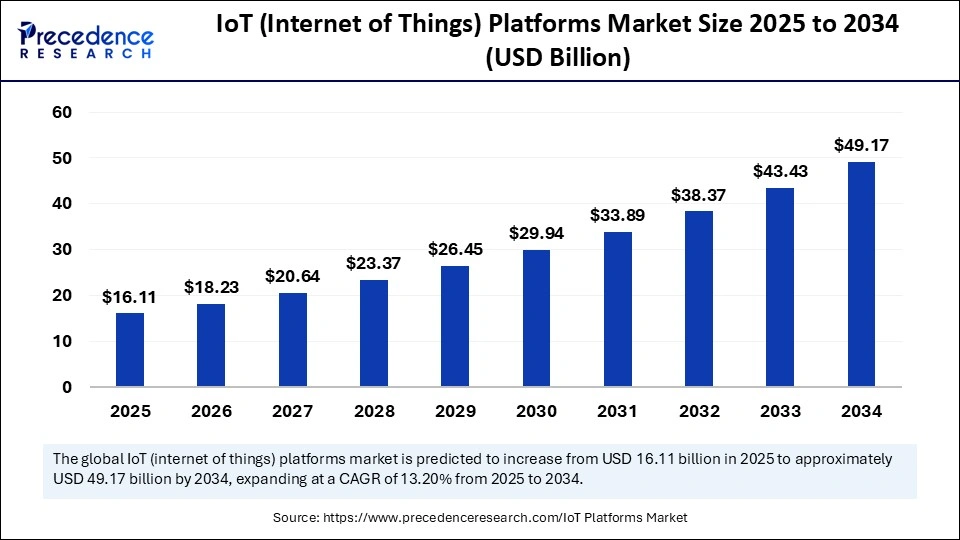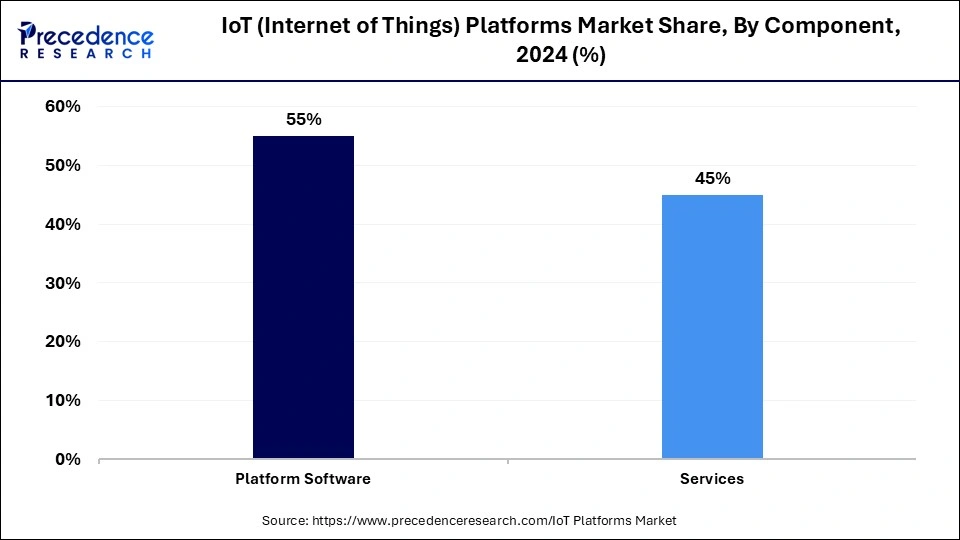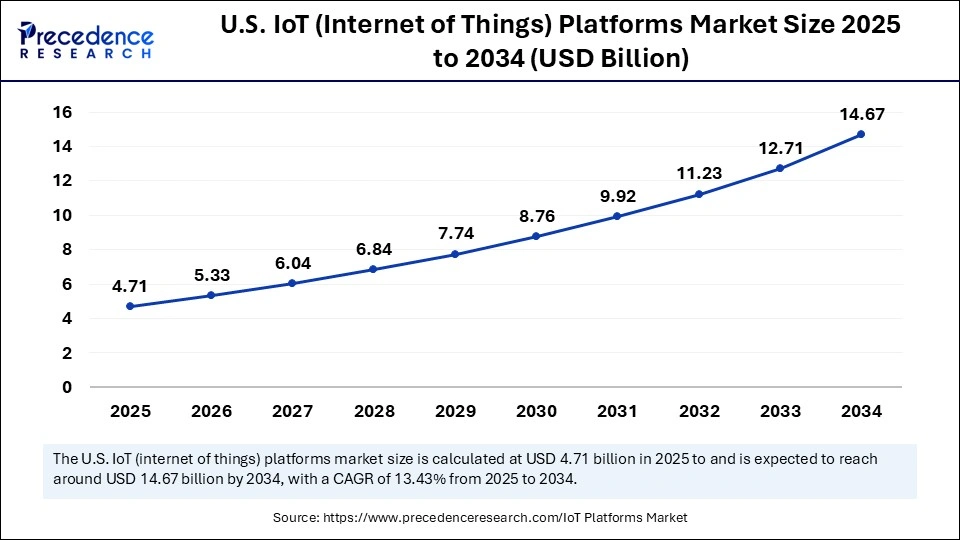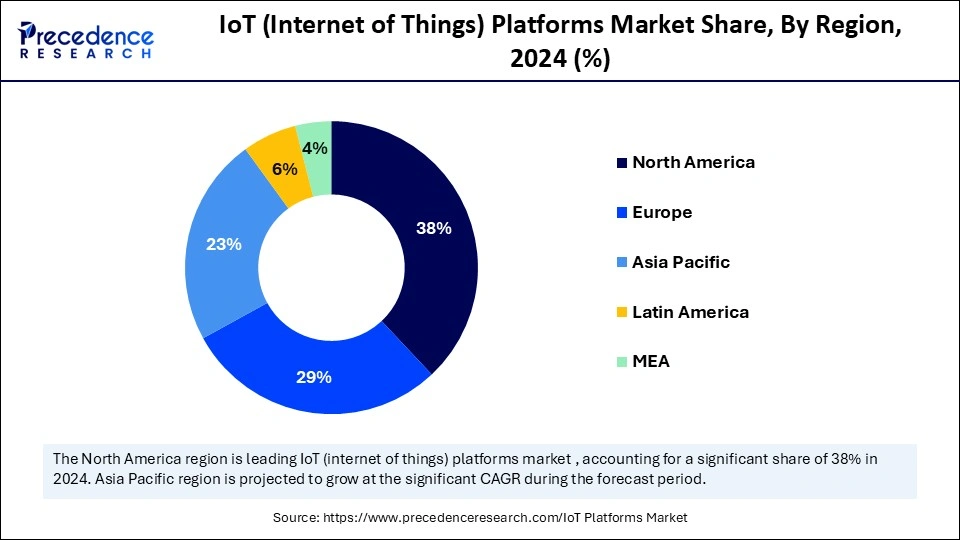List of Contents
What is the IoT (Internet of Things) Platforms Market Size?
The global IoT (internet of things) platforms market size accounted for USD 16.11 billion in 2025 and is predicted to increase from USD 18.23 billion in 2026 to approximately USD 49.17 billion by 2034, expanding at a CAGR of 13.20% from 2025 to 2034. The growth of the market is driven by the rising adoption of connected devices, from consumer electronics to industrial sensors, the increasing integration of AI/ML models across multiple sectors, the rise of edge computing, and substantial investments in smart infrastructure. These developments are generating massive volumes of data that require secure management and automation, further accelerating demand for scalable and intelligent IoT platforms worldwide.

Market Highlights
- By region, North America held the largest market share of 38% in 2024.
- By region, Asia Pacific is expected to expand at the fastest CAGR of 15% from 2025 to 2034.
- By component, the platform software segment contributed the largest market share of 55% in 2024.
- By component, the services segment is growing at a significant CAGR of 13% from 2025 to 2034.
- By deployment mode, the cloud-based / SaaS segment generated the biggest market share of 60% in 2024.
- By deployment mode, the hybrid segment is expected to expand at the fastest CAGR of 12.50% from 2025 to 2034.
- By connectivity technology, the cellular / mobile segment held the largest market share of 40% in 2024.
- By connectivity technology, the LPWAN segment is expected to register the fastest CAGR of 14% from 2025 to 2034.
- By end user / industry vertical, the manufacturing segment held the major market share of 28% in 2024.
- By end user / industry vertical, the healthcare & life sciences segment is expected to expand at the fastest CAGR of 13.50% between 2025 and 2034.
Market Size and Forecast
- Market Size in 2025: USD 16.11 Billion
- Market Size in 2026: USD 18.23 Billion
- Forecasted Market Size by 2034: USD 49.17 Billion
- CAGR (2025-2034): 13.20%
- Largest Market in 2024: North America
- Fastest Growing Market: Asia Pacific
What is IoT (Internet of Things) Platforms Market?
The IoT (Internet of Things) platforms market involves the design, development, and sale of software solutions that connect, analyze, and manage data generated by IoT devices. It plays a vital role within the broader IoT ecosystem by providing the backend infrastructure that ensures the seamless operation of connected devices. The market is experiencing significant expansion, driven by several converging factors, such as the rapid growth of connected devices, the rise of smart homes fueled by urbanization, increased demand for data analytics, and the proliferation of industrial automation under the Industry 4.0 revolution.
Key Technological Shifts in the IoT (Internet of Things) Platforms Market
The major force behind the expansion of the market is the integration of technologies like artificial intelligence with IoT platforms, which enhances the ability to leverage data more effectively, improve operational efficiency, and enable sophisticated applications. AI-powered platforms analyze streaming data in real-time, offering instant solutions while predicting future failures and consumer behavior. A significant advantage of AI integration is its capability to provide actionable insights from vast datasets, empowering organizations to make data-driven decisions that are more accurate and conducive to exponential business growth.
IoT (Internet of Things) Platforms Market Outlook
- Market Growth Overview: The IoT (internet of things) platforms market is poised for robust expansion between 2025 and 2034, driven by continuous technological integration and growing demand across diverse end-use industries recognizing its transformative potential. Core applications such as smart manufacturing and fleet management are key growth drivers. Additionally, the convergence of technologies like machine learning (ML), artificial intelligence (AI), and edge computing is accelerating market growth exponentially.
- Sustainability Trends: Key sustainability trends shaping the IoT Platforms Market include circular economy initiatives and real-time environmental monitoring. These platforms enable organizations to track and report environmental changes captured by IoT devices and sensors, ensuring regulatory compliance and effective disaster management. Furthermore, platforms support circular economy practices by enabling companies to monitor asset lifecycles, particularly in waste management, using smart sensors to optimize collection routes and reduce fuel consumption.
- Global Expansion: Global vendors are targeting emerging economies with adaptive and flexible business models to enhance solution accessibility. Cloud-based service models are predominantly leveraged to provide cost-effective solutions worldwide. The global rollout of 5G and satellite IoT connectivity is a critical enabler, bridging connectivity gaps in remote and underserved regions, thus driving the worldwide expansion of the IoT (internet of things) platforms market.
- Rise of PaaS Models: Platform-as-a-Service (PaaS) models create opportunities in the market by offering scalable, flexible, and cost-effective cloud-based solutions that simplify deployment and management for businesses of all sizes. This enables faster innovation cycles and lowers entry barriers, allowing more industries to adopt IoT technologies without heavy upfront infrastructure investments.
Market Scope
| Report Coverage | Details |
| Market Size in 2025 | USD 16.11 Billion |
| Market Size in 2026 | USD 18.23 Billion |
| Market Size by 2034 | USD 49.17 Billion |
| Market Growth Rate from 2025 to 2034 | CAGR of 13.20% |
| Dominating Region | North America |
| Fastest Growing Region | Asia Pacific |
| Base Year | 2025 |
| Forecast Period | 2025 to 2034 |
| Segments Covered | Component, Deployment Mode, Connectivity Technology, End User / Industry Vertical, Application, Platform Type, and Region |
| Regions Covered | North America, Europe, Asia-Pacific, Latin America, and Middle East & Africa |
Segment Insights
Component Insights
Why Did the Platform Software Segment Lead the IoT (Internet of Things) Platforms Market?
The platform software segment led the market while holding the largest share of 55% in 2024. This dominance is attributed to its role as the foundational layer that manages and integrates a wide array of connected devices. These platforms provide essential tools for data management, analytics, secure device communication, and system interoperability. Such capabilities are critical for enterprises aiming to derive actionable insights and automate routine operations, allowing them to focus on core business improvements.

The services segment is expected to expand at the fastest CAGR of 13% during the forecast period. This growth is driven by the increasing complexity of IoT ecosystems, which require specialized expertise for effective implementation and ongoing management. As more businesses adopt IoT technologies, they rely heavily on deployment, integration, and maintenance services to seamlessly incorporate IoT into their existing IT infrastructure. The demand for skilled services is rising in parallel with the number of connected devices and the need for tailored solutions.
Deployment ModeInsights
What Made Cloud-Based / SaaS the Dominant Segment in the Market?
The cloud-based segment dominated the market with a 60% share in 2024, driven by its superior scalability, flexibility, and cost-effectiveness. Cloud deployment significantly reduces upfront capital expenditure, supports real-time data analytics, and seamlessly integrates with advanced technologies such as AI and machine learning. Moreover, cloud-based platforms enable remote device management and over-the-air updates, making them a highly preferred option across various industries for streamlined operations and global accessibility.
The hybrid segment is expected to grow at a CAGR of 12.50% during the foreseeable period. The segment's growth is attributed to its ability to provide a balanced architecture that leverages the strengths of both public and private cloud environments. Hybrid deployments offer organizations greater control over sensitive data, improved security, and reduced latency, all without requiring a complete overhaul of existing infrastructure. This makes it particularly attractive for sectors where data sovereignty, compliance, and real-time processing are mission critical.
Connectivity TechnologyInsights
How Does the Cellular / Mobile Segment lead the Market in 2024?
The cellular / mobile (2G/3G/4G/5G/5G NR) segment led the IoT (internet of things) market by holding a 40% share in 2024. This segment dominates due to its ability to deliver wide-area coverage, high reliability, and support for a broad spectrum of IoT applications, from high-speed broadband to low-power devices. Cellular technologies also enable connectivity in remote or geographically dispersed areas, making them ideal for asset tracking, fleet management, and smart city infrastructure where reliable and continuous connectivity is critical.
The LPWAN segment is expected to expand at the fastest CAGR of 14% during the foreseeable period. The growth of the segment is driven by LPWAN's capability to offer long-range, low-power, and cost-efficient connectivity, making it well-suited for IoT applications that transmit small amounts of data at regular intervals. Key sectors adopting LPWAN include smart cities, logistics, agriculture, and utilities, where devices require extended battery life and minimal maintenance over dispersed networks.
End User / Industry Vertical Insights
Why Did the Manufacturing Segment Hold the Largest Market Share in 2024?
The manufacturing segment held the largest market share of 28% in 2024, driven by the sector's strong emphasis on enhancing operational efficiency, automation, and cost optimization. The adoption of IoT technologies allows manufacturers to gain real-time insights into production processes, implement predictive maintenance, optimize supply chain operations, and improve quality control. These capabilities are critical for manufacturers to remain competitive in a globalized industrial landscape.
The healthcare & life sciences segment is expected to grow at the fastest CAGR of 13.50% during the foreseeable period. The segment's growth is primarily attribute to the rising prevalence of chronic diseases, coupled with an aging population that requires long-term health monitoring and care. IoT integration in healthcare is driving a shift toward patient-centric, cost-effective solutions, offering real-time data for remote monitoring, personalized treatment, and improved clinical outcomes.
Regional Insights
U.S. IoT (Internet of Things) Platforms Market Size and Growth 2025 to 2034
The U.S. IoT (internet of things) platforms market size is exhibited at USD 4.71 billion in 2025 and is projected to be worth around USD 14.67 billion by 2034, growing at a CAGR of 13.43% from 2025 to 2034.

Which Factors Support North America's Dominance in the IoT (Internet of Things) Platform Market?
North America dominated the market by holding the largest share of 38% in 2024. This dominance is attributed to the region's mature technological infrastructure and high adaptability to emerging technologies, enabling widespread adoption of IoT across sectors such as manufacturing, healthcare, and agriculture. The strong presence of leading technology companies further accelerates the integration of IoT platforms, enhancing operational efficiency through real-time monitoring, data-driven decision-making, and predictive maintenance.
U.S. IoT (Internet of Things) Platforms Market Trends
The U.S. market is witnessing robust growth driven by the expansion of 5G networks, enabling faster speeds and ultra-low latency communication. Additionally, the convergence of IoT with AI and machine learning, supported by a robust cloud infrastructure, is transforming data collected from IoT devices into actionable insights. This convergence is significantly enhancing predictive analytics and enabling smarter automation across industries.
Moreover, the U.S. serves as a hub for leading tech giants such as AWS, Microsoft, Google, and IBM, all of which are actively advancing the adoption of IoT technologies across key sectors like healthcare and manufacturing. Strategic collaborations, partnerships, and acquisitions by these companies are further fueling the demand for IoT platforms, reinforcing the U.S. position as a dominant player in the market.

What Makes Asia Pacific the Fastest-Growing Market for IoT (Internet of Things) Platforms?
Asia Pacific is expected to grow at the fastest CAGR of 15% during the foreseeable period of 2025-2034. The regional market growth is driven by government-backed initiatives, rapid urbanization, and the digital transformation of key industries. The region is witnessing significant investment in smart city development, 5G infrastructure, and advanced connectivity frameworks, which are foundational to the adoption of industrial IoT.
Emerging economies such as India, China, and Japan are experiencing rising demand for smart technologies in sectors like energy management, transportation, and public safety, all essential components of sustainable urban development. Moreover, Asia Pacific's strong manufacturing base, particularly in electronics and automotive, further accelerates IoT integration, making the region a strategic growth engine for the market.
China IoT (Internet of Things) Platforms Market Analysis
China is experiencing robust growth in the market due to massive investment in advanced 5G infrastructure, government-backed initiatives, and its leading position in the electronics sector. Initiatives like “Made in China 2025” and “Internet Plus” have cultivated high-tech industries in China, including the integration of IoT. The massive funding for foundational IoT infrastructure and the significant investments by state-owned telecom companies to expand their networks are other key predictors of the market.
How is the Opportunistic Rise of Europe in the Market?
Europe is expected to grow at a notable rate in the market. This growth is driven by factors such as significant industrial digitalization and strong government support for adopting key technologies that focus on data protection and sustainability. The European Union has several programs, like Horizon Europe and the Digital Europe Program, that support IoT technology development and pilot projects in many leading sectors across Europe.
Germany IoT (Internet of Things) Platforms Market Trends
Germany is contributing substantially to the expansion of the market. Strict regulations like GDPR have pushed for the establishment of highly secure and compliant IoT platforms, fueling the adoption of IoT in major sectors like healthcare and finance. Also, government-backed programs like the Digital Jetzt program offer subsidies and grants to help SMEs adopt IoT technologies.
IoT (Internet of Things) Platforms Market Value Chain Analysis
- Hardware Manufacturing
This foundational stage involves manufacturing physical devices such as sensors and actuators, which enable data collection and interaction across IoT systems.
Key players: Intel, Qualcomm, Texas Instruments, STMicroelectronics.
- Connectivity & Network Infrastructure
In this stage, robust communication networks such as cellular (4G/5G), LPWAN, Wi-Fi, and satellite networks are deployed to ensure seamless and reliable data transmission between IoT devices and platforms. Efficient connectivity reduces latency and prevents data loss, which is critical for real-time IoT applications like smart cities and industrial automation.
Key players: AT&T, Verizon, Vodafone, Sigfox, Ingenu.
- Middleware and Platforms Development
Middleware platforms act as the backbone of the IoT ecosystem by bridging hardware devices and application layers. They provide essential services including device management, data ingestion, processing, analytics, security, and integration with cloud services, enabling businesses to build scalable and secure IoT solutions without dealing with the complexity of raw data streams.
Key players: AWS, Microsoft Azure IoT, Google Cloud IoT, and various open-source platforms.
Top Companies in the IoT (Internet of Things) Platforms Market
| Tier | Companies | Rationale / Roles | Estimated Cumulative Share |
| Tier I – Major Players | Microsoft, Amazon Web Services (AWS), Huawei, Alibaba, Oracle | These are dominant hyperscalers or technology providers with extensive IoT platform capabilities, massive cloud infrastructure, and global enterprise adoption. They lead in scalability, breadth of services, and integrations with edge, analytics, and AI. Their platforms (e.g., Azure IoT, AWS IoT Core) often serve as the backbone for large-scale industrial, smart city, and commercial IoT deployments. | ~50% |
| Tier II – Established Players | Cisco (Jasper), PTC (ThingWorx), IBM, Google Cloud, SAP, General Electric (Predix) | These companies have solid IoT platforms with strong vertical specialization (e.g., industrial, automotive, telecom). They're often leaders in specific areas: connectivity management (Cisco), industrial IoT (PTC, GE), cloud analytics (Google), and enterprise integration (SAP). While powerful, they typically serve more focused use cases or have more limited scale compared to Tier I. | ~30% |
| Tier III – Emerging / Niche Players | Bosch IoT Suite, Hitachi Vantara, Telit, Software AG (Cumulocity), Arm Pelion, Uptake, ClearBlade, Altair, Kaa IoT, Losant, others | These are smaller firms or focused players with platforms tailored to niche markets or specific layers of the IoT stack (device management, analytics, edge computing). They may lead in particular geographies, verticals (like smart buildings, mobility, utilities), or offer OEM/white-label solutions. Many are innovating in edge, open-source frameworks, or low-latency industrial applications. | ~20% |
Recent Developments
- In October 2025, AT&T and Ericsson launched the AT&T IoT Marketplace, a digital e-Commerce platform that simplifies selling, contracting, provisioning, and billing of IoT services. Featuring a comprehensive digital catalog, order management, and TMF API integration, it enables efficient service innovation and monetization for industries like transportation, manufacturing, and healthcare, supporting AT&T's expanding IoT business. (Source: https://www.ericsson.com)
- In October 2025, Telia launched the Telia IoT Platform to help Nordic enterprises deploy and scale IoT solutions. The platform enables data collection, visualization, and action from connected devices, with built-in AI for analysis and optimization. Telia also introduced its first add-on service: Telia IoT Monitoring.
(Source: https://www.teliacompany.com) - In January 2025, the U.S. introduced a cyber trust mark for IoT devices, allowing consumers to access the cybersecurity standards easily. It shows that the products have met cybersecurity regulations according to the standards set by the U.S.(Source: https://www.infosecurity-magazine.com)
Exclusive Analysis on the IoT (Internet of Things) Platforms Market
The global IoT (internet of things) platforms market is poised for exponential growth, driven by the accelerating digitization across industries and the pervasive integration of connected devices in enterprise ecosystems. From a strategic research perspective, the market's trajectory is underpinned by transformative trends such as edge computing proliferation, AI-augmented analytics, and seamless interoperability frameworks, which collectively elevate platform sophistication and scalability.
Crucially, the evolution of 5G infrastructure and enhanced cybersecurity protocols catalyze enterprise confidence in deploying IoT solutions at scale, unlocking untapped verticals, ranging from smart manufacturing and autonomous mobility to precision healthcare and energy management. This momentum engenders a fertile environment for platform providers to innovate modular, AI-enabled offerings that address complex data orchestration, real-time decisioning, and device lifecycle management.
Moreover, the rising emphasis on sustainability and operational efficiency amplifies demand for IoT-enabled predictive maintenance, asset optimization, and supply chain transparency solutions, thereby broadening the market's addressable use cases. The commoditization of hardware juxtaposed with the premium on software-driven insights positions IoT platforms as the critical nexus for value capture, making them indispensable to digital transformation agendas globally.
- In sum, the market embodies a high-potential, dynamic ecosystem with compelling opportunities for incumbents and disruptors alike to leverage technological convergence, strategic partnerships, and vertical specialization to capture significant share and drive innovation-led growth.
Segments Covered in the Report
By Component
- Platform Software
- Device Management
- Application Enablement / Development
- Data Management & Analytics
- Security & Identity Management
- Integration Middleware
- Services
- Consulting & System Integration
- Managed Services
- Support & Maintenance
By Deployment Mode
- Cloud-Based / SaaS
- On-Premises / Private Cloud
- Hybrid
By Connectivity Technology
- Cellular / Mobile (2G/3G/4G/5G/5G NR)
- LPWAN (LoRaWAN, Sigfox, NB-IoT)
- Wi-Fi / Wireless LAN
- Bluetooth / BLE
- Zigbee / Thread
- Satellite Communication
- Ethernet / Wired Connections
By End User / Industry Vertical
- Manufacturing (Smart Factories / Industry 4.0)
- Healthcare & Life Sciences
- Remote Patient Monitoring
- Hospital Asset Management
- Transportation & Logistics
- Fleet Management
- Smart Traffic Systems
- Retail & E-Commerce
- Smart Stores
- Inventory & Supply Chain Management
- Energy & Utilities
- Smart Grid
- Energy Management Systems
- Automotive & Connected Vehicles
- Agriculture / Smart Farming
- Smart Homes & Buildings
- Government / Smart Cities
- Others (Defense, Hospitality, Education)
By Application
- Remote Monitoring & Control
- Predictive Maintenance
- Asset Tracking & Management
- Fleet & Transportation Management
- Energy Management & Optimization
- Healthcare Monitoring & Diagnostics
- Security & Surveillance
- Smart Building / Home Automation
- Industrial Automation & Control
- Others
By Platform Type
- Device Management Platforms
- Application Enablement Platforms
- Analytics & Data Platforms
- Security & Identity Platforms
- Integration & Middleware Platforms
By Region
- North America
- Europe
- Asia-Pacific
- Latin America
- Middle East and Africa
For inquiries regarding discounts, bulk purchases, or customization requests, please contact us at sales@precedenceresearch.com
Frequently Asked Questions
Ask For Sample
No cookie-cutter, only authentic analysis – take the 1st step to become a Precedence Research client